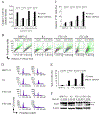Therapeutic inhibition of ATR in differentiated thyroid cancer
- PMID: 37902083
- PMCID: PMC11271744
- DOI: 10.1530/ERC-23-0142
Therapeutic inhibition of ATR in differentiated thyroid cancer
Abstract
Ataxia telangiectasia and Rad3-related protein (ATR) is a critical component of the DNA damage response and a potential target in the treatment of cancers. An ATR inhibitor, BAY 1895344, was evaluated for its use in differentiated thyroid cancer (DTC) therapy. BAY 1895344 inhibited cell viability in four DTC cell lines (TPC1, K1, FTC-133, and FTC-238) in a dose-dependent manner. BAY 1895344 treatment arrested DTC cells in the G2/M phase, increased caspase-3 activity, and caused apoptosis. BAY 1895344 in combination with either sorafenib or lenvatinib showed mainly synergistic effects in four DTC cell lines. The combination of BAY 1895344 with dabrafenib plus trametinib revealed synergistic effects in K1 cells that harbor BRAFV600E. BAY 1895344 monotherapy retarded the growth of K1 and FTC-133 tumors in xenograft models. The combinations of BAY 1895344 plus lenvatinib and BAY 1895344 with dabrafenib plus trametinib were more effective than any single therapy in a K1 xenograft model. No appreciable toxicity appeared in animals treated with either a single therapy or a combination treatment. Our findings provide the rationale for the development of clinical trials of BAY 1895344 in the treatment of DTC.
Keywords: ATR; BAY 1895344; combination therapy; dabrafenib; differentiated thyroid cancer; lenvatinib; sorafenib; trametinib.
Conflict of interest statement
Declaration of interest
The authors have no conflict of interest.
Figures






References
-
- Brose MS, Nutting CM, Jarzab B, Elisei R, Siena S, Bastholt L, de la Fouchardiere C, Pacini F, Paschke R, Shong YK, et al. 2014. Sorafenib in radioactive iodine-refractory, locally advanced or metastatic differentiated thyroid cancer: a randomised, double-blind, phase 3 trial. Lancet 384 319–328. (10.1016/s0140-6736(14)60421-9) - DOI - PMC - PubMed
-
- Brose MS, Robinson B, Sherman SI, Krajewska J, Lin CC, Vaisman F, Hoff AO, Hitre E, Bowles DW, Hernando J, et al. 2021. Cabozantinib for radioiodine-refractory differentiated thyroid cancer (COSMIC-311): a randomised, double-blind, placebo-controlled, phase 3 trial. The Lancet Oncology 22 1126–1138. (10.1016/s1470-2045(21)00332-6) - DOI - PubMed
Publication types
MeSH terms
Substances
Grants and funding
LinkOut - more resources
Full Text Sources
Medical
Research Materials
Miscellaneous

